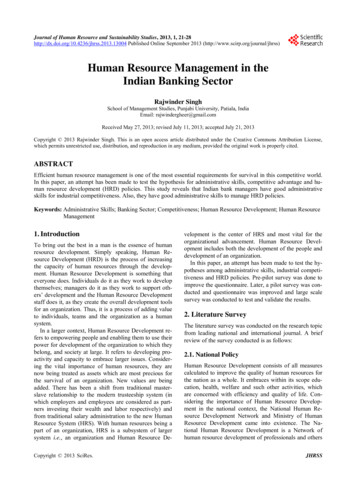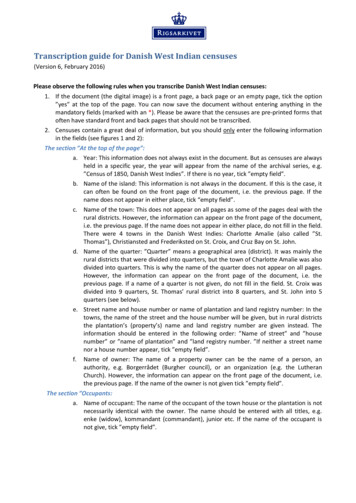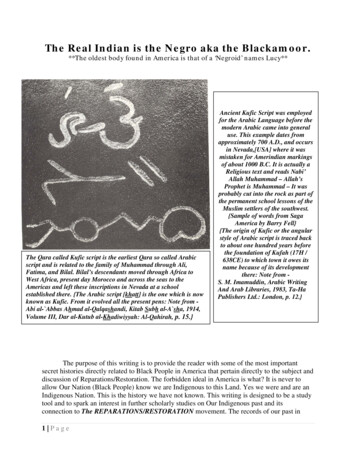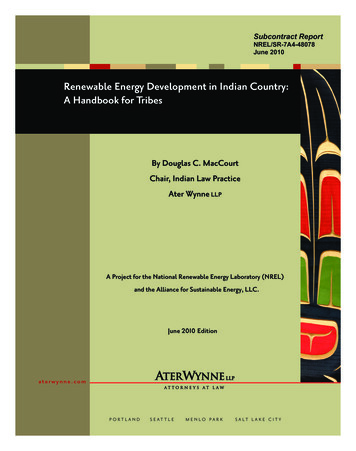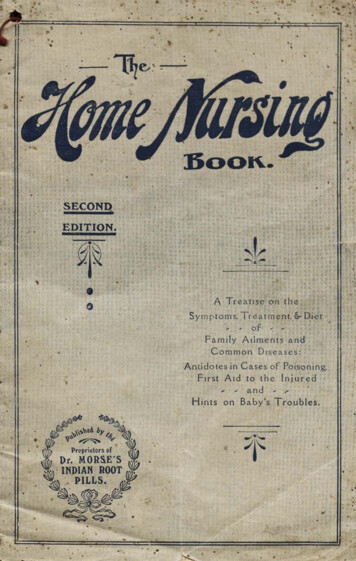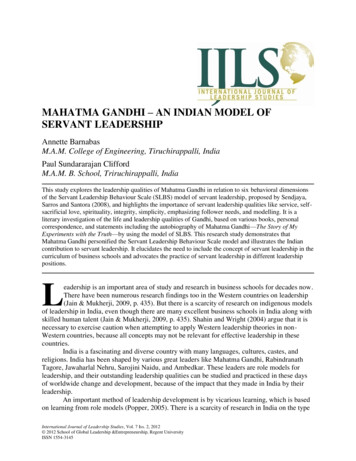
Transcription
MAHATMA GANDHI – AN INDIAN MODEL OFSERVANT LEADERSHIPAnnette BarnabasM.A.M. College of Engineering, Tiruchirappalli, IndiaPaul Sundararajan CliffordM.A.M. B. School, Triruchirappalli, IndiaThis study explores the leadership qualities of Mahatma Gandhi in relation to six behavioral dimensionsof the Servant Leadership Behaviour Scale (SLBS) model of servant leadership, proposed by Sendjaya,Sarros and Santora (2008), and highlights the importance of servant leadership qualities like service, selfsacrificial love, spirituality, integrity, simplicity, emphasizing follower needs, and modelling. It is aliterary investigation of the life and leadership qualities of Gandhi, based on various books, personalcorrespondence, and statements including the autobiography of Mahatma Gandhi—The Story of MyExperiments with the Truth—by using the model of SLBS. This research study demonstrates thatMahatma Gandhi personified the Servant Leadership Behaviour Scale model and illustrates the Indiancontribution to servant leadership. It elucidates the need to include the concept of servant leadership in thecurriculum of business schools and advocates the practice of servant leadership in different leadershippositions.Leadership is an important area of study and research in business schools for decades now.There have been numerous research findings too in the Western countries on leadership(Jain & Mukherji, 2009, p. 435). But there is a scarcity of research on indigenous modelsof leadership in India, even though there are many excellent business schools in India along withskilled human talent (Jain & Mukherji, 2009, p. 435). Shahin and Wright (2004) argue that it isnecessary to exercise caution when attempting to apply Western leadership theories in nonWestern countries, because all concepts may not be relevant for effective leadership in thesecountries.India is a fascinating and diverse country with many languages, cultures, castes, andreligions. India has been shaped by various great leaders like Mahatma Gandhi, RabindranathTagore, Jawaharlal Nehru, Sarojini Naidu, and Ambedkar. These leaders are role models forleadership, and their outstanding leadership qualities can be studied and practiced in these daysof worldwide change and development, because of the impact that they made in India by theirleadership.An important method of leadership development is by vicarious learning, which is basedon learning from role models (Popper, 2005). There is a scarcity of research in India on the typeInternational Journal of Leadership Studies, Vol. 7 Iss. 2, 2012 2012 School of Global Leadership &Entrepreneurship, Regent UniversityISSN 1554-3145
Barnabas & Paul/ INTERNATIONAL JOURNAL OF LEADERSHIP STUDIES133of leadership that can be taught and practiced in leadership development programs and BusinessSchools based on these indigenous role models (Jain & Mukherji, 2009, p. 435). This study aimsto study the servant leadership qualities of Mahatma Gandhi, the great role model of truth andnon-violence in Indian history (Nair, 1994, p. 7), and the great freedom fighter and servant leaderfrom India, so that this concept can be taught and practiced by Indian and worldwide leaders.Gandhi is widely acknowledged as one of the greatest leaders of the non-violentmovements the world has ever seen. As a pioneer of Satyagraha (Shridharani, 1939), which isresistance through non-violent civil disobedience, he became one of the major political leaders ofhis time. Many other great leaders, like Martin Luther King Jr. (McGuire & Hutchings, 2007, p.154) and Nelson Mandela (Fawell, 2007, p. 228), were inspired by the philosophy of nonviolence of Gandhi. Many writers have acknowledged that Gandhi was a servant leader (Sims,1994; Koshal, 2005; Blanchard & Miller, 2007; Nordquist, 2008; Salleh, 2009). Albert Einstein(1939, p. 80) referred to Gandhi as ‘a beacon to the generations to come.’The purpose of this paper is to re-examine the outstanding qualities of servant leadershipthat Gandhi provided and deconstruct the constituent components of his leadership to arrive at abetter understanding of the qualities, characteristics, and effectiveness of servant leadership. Fordand Lawler (2007) find that the dominance of the behavioral and attitudinal dimensions inquantitative empirical studies of leadership has resulted in a relative dearth of qualitativeapproaches. There is hardly any study to find out whether Gandhi possessed all thecharacteristics of a servant leader. For this purpose, the Servant Leadership Behaviour Scale(SLBS) model of servant leadership with six dimensions proposed by Sendjaya, Sarros, andSantora (2008) is used in this study to examine the servant leadership qualities of Gandhi. ThisSLBS scale was developed as a result of extensive review of literature and it reflects a morecomprehensive construct of servant leadership compared with existing measures.The paper begins with a brief definition of servant leadership and the Indian origin ofleadership concept. This is followed by an examination of the model of servant leadership andthe investigation of the extent to which Mahatma Gandhi exemplified these qualities, asindicated by reference to excerpts from his personal life and work. The paper concludes with adiscussion of how the servant leadership characteristics initiated by Gandhi can be studied andpractised in India and all over the world.Introduction to Servant LeadershipRobert K. Greenleaf coined the modern term servant-leadership (Spears, 1996) in 1970in the essay entitled, The Servant as Leader, after reading Herman Hesse’s (1956) short novel,Journey to the East. After reading this story, Greenleaf concluded that the central meaning ofthis novel was that a great leader must first of all become a servant and get the experience as aservant, and that this is central to his or her greatness (Spears, 1996). There are many passages inthe Bible which depict the servant leadership qualities of Jesus Christ of Nazareth, who lived inthe first century A.D. and taught His disciples, “But he who is greatest among you shall be yourservant” (Matt. 23:11; New King James Version of the Holy Bible). Jesus modelled His teachingon servant leadership by washing the feet of His disciples, including the one who was to betrayHim.International Journal of Leadership Studies, Vol. 7 Iss. 2, 2012 2012 School of Global Leadership &Entrepreneurship, Regent UniversityISSN 1554-3145
Barnabas & Paul/ INTERNATIONAL JOURNAL OF LEADERSHIP STUDIES134Indian Origin of Servant Leadership ConceptThe Mahabharata, written by Rishi Veda Vyasa, is one of the two major Sanskrit epics ofancient India, the other being the Rāmāyana (Hee, 2007). The Bhagavad Gita is part of theMahabharata and is one of the most revered Hindu manuscripts. Rarick and Nickerson (2009)state that a leader as per Gita tradition is a humanistic leader, a person who acts without selfgain, and who has great personal concern for followers. The Bhagavad Gita, while enlisting thequalities of a superior person, says that “he is one who hates no creature, who is friendly andcompassionate to all, who is free from attachment and egoism, balanced in pleasure and pain,and forgiving” (Sivananda, 2000: 12:13). Thus, the Bhagavad Gita teaches some importantconcepts of servant leadership.Arthasastra, written by Kautilya, is an ancient Indian treatise in management. Kautilyawas the minister and adviser of King Chandragupta Maurya, who ruled North India in the 4thcentury B. C. (Muniapan & Dass, 2008). In Arthasastra, Kautilya (1915), while listing the dutiesof a king, wrote, “In the happiness of his subjects lies his happiness; in their welfare his welfare;whatever pleases himself he shall not consider as good, but whatever pleases his subjects he shallconsider as good.”Journey to the East, written by Hesse, which is the book which prompted Greenleaf topropose and propagate the concept of servant leadership, is rich in ancient Eastern religioustradition, primarily the Hindu tradition (Sendjaya et al., 2008). Trompenaars and Voerman(2010), in the book Servant Leadership across Cultures, cite examples from Indian culture toshow that servant leadership was practised in ancient India. Rabindranath Tagore, the NobelLaureate for Literature from India, said philosophically: ‘I slept and dreamt that life was joy. Iawoke and saw that life is service. I acted and behold, service was joy’ (Rude, 2003). Thus thereare ample evidences in Indian literature that servant leadership was propagated and practiced inIndia.Brief Profile of M. K. GandhiMohandas Karamchand Gandhi, known as Mahatma Gandhi and the great leader of themasses in India, is the important architect and significant leader of the Indian freedom struggle.Gandhii was born on October 2, 1869. He was a below average student and very shy during hisschool days. Gandhi went to England to study law in 1888. After finishing law school, hereturned to India in 1891. Unable to practice law in India, he left for South Africa in 1893. Hisjoy knew no bounds when he helped to resolve and settle a difficult, out of court legal disputethat involved his firm in South Africa. About his experience and joy, Gandhi (1948a, p. 168)wrote, “My joy was boundless. I had learnt the true practice of law. I had learned to find out thebetter side of human nature and to enter men's hearts.” Then Gandhi’s outlook changed and helooked forward to rendering service rather than making profit. In South Africa, he experiencedthe sufferings of the Indians due to racial tensions. This prompted him to lead the Indians to fightagainst racial problems by adopting the strategy of Ahimsa (non-violence) and Satyagraha(holding on to truth) (Heath, 1944). When he returned to India, he led Indians to fight the Britishwith the same weapons. He was imprisoned many times when he practiced these principles ofnon-violence and underwent fasting. These servant leadership principles, applied in practice,forced the British to declare independence. At the stroke of midnight, on August 14, 1947, Indiabecame an independent nation. This was followed by a bitter struggle between the Hindus andInternational Journal of Leadership Studies, Vol. 7 Iss. 2, 2012 2012 School of Global Leadership &Entrepreneurship, Regent UniversityISSN 1554-3145
Barnabas & Paul/ INTERNATIONAL JOURNAL OF LEADERSHIP STUDIES135Muslims who lived in India and Pakistan. On January 30, 1948, Nathuram Godse assassinatedGandhi (Murphy, 2005) because Gandhi took a stand to make peace with Muslims by nonviolent means and supported them even though he was a Hindu. On the day of his demise,nations all over the world paid homage to Gandhi.The world acknowledged his special place when the United Nations flew its flag at halfmast when he was assassinated. He is the only individual with no connection to anygovernment or international organisation for whom this has been done. (Nair, 1994, p. 2)It was Rabindranath Tagore who popularized the term Mahatma which means great soul (Sen,2004, p. 181). Gandhi was called Mahatma Gandhi because of his great ideals and contributionto the development of India as a nation.The Servant Leadership Behaviour Scale ModelSendjaya et al., (2008) identified more than 20 themes pertinent to servant leadership byextensive review of the literature and categorized them into six different dimensions of servantleadership behavior. They called it the Servant Leadership Behaviour Scale (SLBS), whichconsisted of six dimensions, namely Voluntary Subordination, Authentic Self, CovenantalRelationship, Responsible Morality, Transcendental Spirituality, and Transforming Influence.This SLBS model relates very well with existing empirical models of servant leadership, namelyLaub’s (2003) Organizational Leadership Assessment, Wong and Page’s (2003) Revised ServantLeadership Profile, Barbuto and Wheeler’s (2006) Servant Leadership Questionnaire, andWhittington, Frank, May, Murray and Goodwin’s (2006) Servant Shepherd Leadership Scale.The SLBS model extends the existing instruments by adding two important dimensions,namely spirituality and the morality-ethics dimension, both of which are omitted by others(Sendjaya et al., 2008). The validity and reliability of the SLBS were verified through acombination of qualitative and quantitative methods, including semi-structured interviews with15 senior executives, content validity tested by quasi-quantitative approach, confirmatory factoranalysis, and internal consistency reliability estimation (Sendjaya et al., 2008). Chathury (2008)has used SLBS model in his study and criterion validity (concurrent) is tested as part of thisstudy by correlating servant leadership with perceptions of trust as measured by theOrganizational Trust Inventory (Nyhan & Marlowe, 1997), and discriminative validity is alsoverified. Thus the SLBS model appears to be the most comprehensive instrument in its coverageof servant leadership characteristics and was used as part of this study.Leadership Qualities of Mahatma Gandhi in relation to SLBS ModelThe literary enquiry on the six behavioral dimensions of this model on Mahatma Gandhiis given below.Voluntary SubordinationThis quality is a revolutionary act of will to voluntarily abandon one’s self to others bybeing a servant and by acts of service (Sendjaya, 2005). According to Nair (1994), Gandhi was asymbol of service to mankind.While most leaders identify with symbols of power to elevate themselves above thepeople they lead, Gandhi symbolized the people he was trying to serve. He tried to be likeInternational Journal of Leadership Studies, Vol. 7 Iss. 2, 2012 2012 School of Global Leadership &Entrepreneurship, Regent UniversityISSN 1554-3145
Barnabas & Paul/ INTERNATIONAL JOURNAL OF LEADERSHIP STUDIES136them with his loin cloth and his commitment to voluntary poverty. He symbolized servicerather than power. (Nair, 1994, p. 6)Gandhi had the two outstanding qualities of voluntary subordination namely being aservant, c
This study explores the leadership qualities of Mahatma Gandhi in relation to six behavioral dimensions of the Servant Leadership Behaviour Scale (SLBS) model of servant leadership, proposed by Sendjaya, Sarros and Santora (2008), and highlights the importance of servant leadership qualities like service, self-
